

| Go to Market Strategy James Hardie |
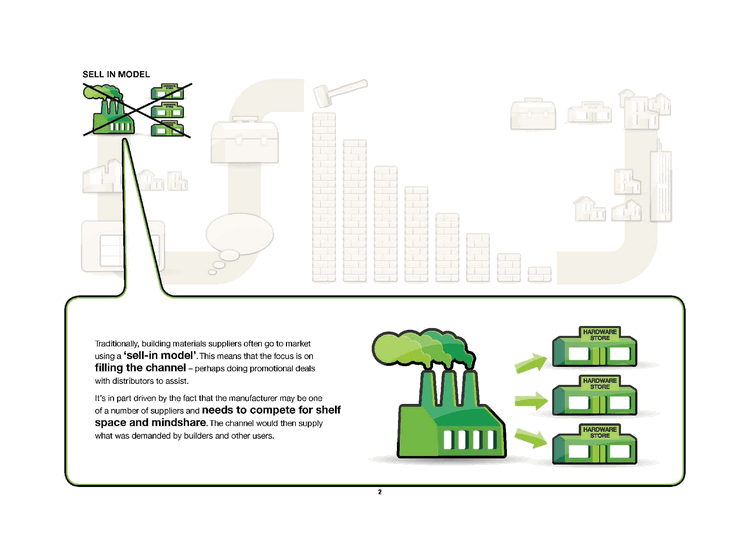
| SELL IN MODEL Traditionally, building materials suppliers often go to market using a 'sell-in model'. This means that the focus is on filling the Channel - perhaps doing promotional deals with distributors to assist. It's in part driven by the fact that the manufacturer may be one of a number of suppliers and needs to compete for shelf Space and mindshare.The channel would then supply what was demanded by builders and other users. |
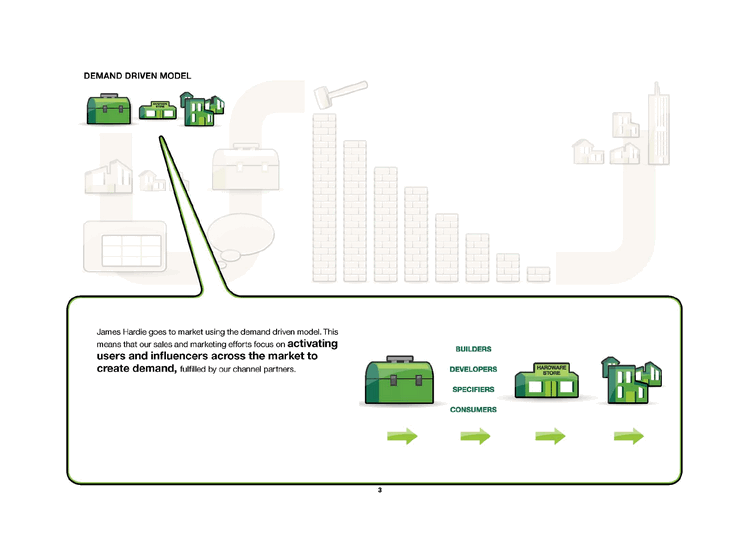
| DEMAND DRIVEN MODEL James Hardie goes to market using the demand driven model.This means that our sales and marketing efforts focus on activating users and influencers across the market to create demand, fulfilled by our channel partners. BUILDERS DEVELOPERS SPECIFIERS CONSUMERS |

| DEMAND DRIVEN MODEL FEATURE TO MAINSTREAM TOP 100 9,300 SMALL-MED BUILDERS Traditionally, while James Hardie has had the primary share of the fibre cement category, the use of the product has been largely limited to 'features'. That is, small uses of the product as a design accent. We recognised that with part of the sales team focussed on large builders (the top 100 build half the housing starts nationally) and a channel team with a traditional focus predominantly on channel partner relationships, we would not adequately touch small to medium builders (9300 builders building the other 50% of housing starts (custom new homes) and 160,000 renovations). We therefore deliberately put a strategy in place that would ensure the channel played an equal demand generation role. Our approach is to use channel partners as the vehicle to aggregate and attract these builder targets and change their behaviours. Where the primary demand sales team is a one to one relationship, the channel sales team is one to many. The endgame is to have more product, on more buildings. |
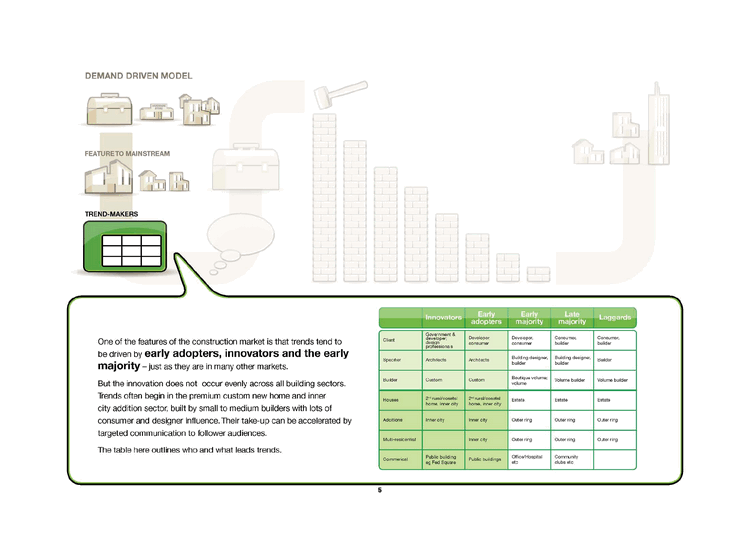
| DEMAND DRIVEN MODEL FEATURE TO MAINSTREAM TREND-MAKERS One of the features of the construction market is that trends tend to be driven by early adopters, innovators and the early majority - just as they are in many other markets. But the innovation does not occur evenly across all building sectors. Trends often begin in the premium custom new home and inner city addition sector, built by small to medium builders with lots of consumer and designer influence. Their take-up can be accelerated by targeted communication to follower audiences. The table here outlines who and what leads trends. Innovators Early Early Late Laggards adopters majority majority Client Government & Developer, consumer Developer, consumer Consumer. builder Consumer, builder developer: design Professionals Specifier Architects Architects Building designer, builder Building designer, builder Builder Builder Custom Custom Boutique volume; volume Volume builder Volume builder Houses 2"d rural/coastal 2nd rural/coastal Estate Estate Estate home, inner city home, inner city Additions Inner city Inner city Outer ring Outer ring Outer ring Multi-residential Inner city Outer ring Outer ring Outer ring Commerical Public building eg Fed Squars Public buildings Office/Hospital Community clubs etc etc |
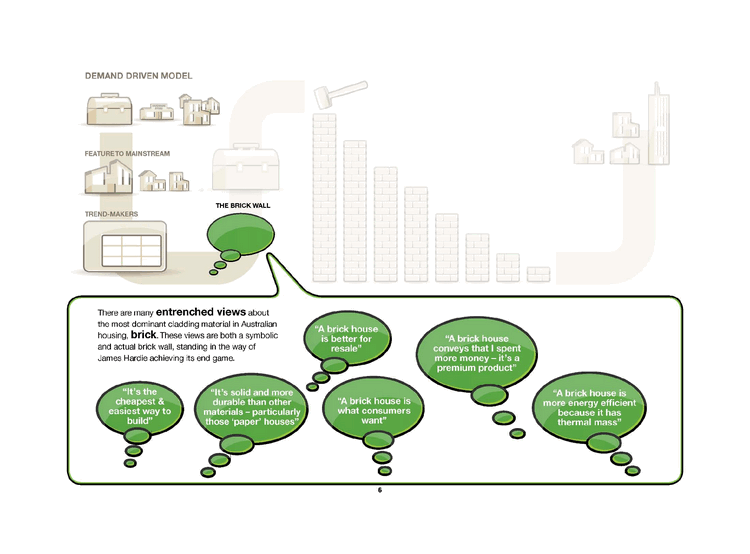
| DEMAND DRIVEN MODEL FEATURE TO MAINSTREAM TREND-MAKERS THE BRICK WALL There are many entrenched views about the most dominant cladding material in Australian housing, brick. These views are both a symbolic and actual brick wall, standing in the way of James Hardie achieving its end game. "A brick house is better for resale" "A brick house conveys that I spent more money - it's a premium product" It's the cheapest & easiest way to build" "It's solid and more durable than other materials - particularly those 'paper' houses" "A brick house is what consumers want" A brick house is more energy efficient because it has thermal mass" |
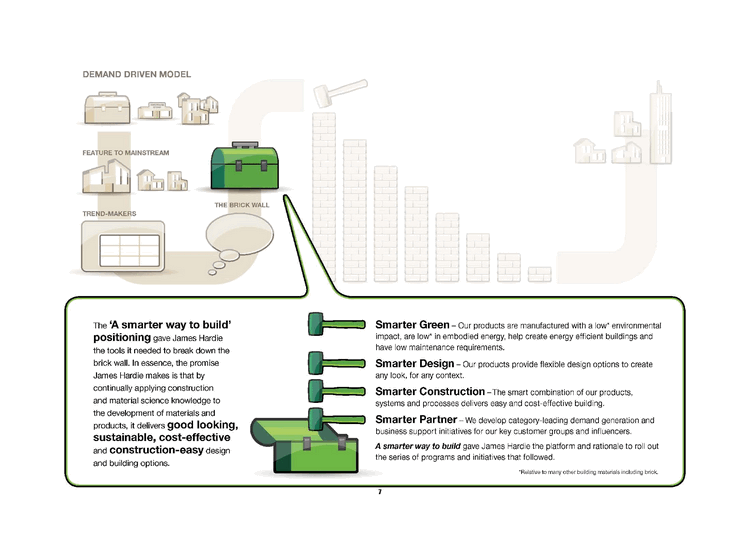
| DEMAND DRIVEN MODEL FEATURE TO MAINSTREAM THE BRICK WALL TREND-MAKERS The 'A smarter way to build' positioning gave James Hardie the tools it needed to break down the brick wall. In essence, the promise James Hardie makes is that by continually applying construction and material science knowledge to the development of materials and products, it delivers good looking, sustainable, cost-effective and construction-easy design and building options. Smarter Green - Our products are manufactured with a low* environmental impact, are low* in embodied energy, help create energy efficient buildings and have low maintenance requirements. Smarter Design - Our products provide flexible design options to create any look, for any context. Smarter Construction -The smart combination of our products, systems and processes delivers easy and cost-effective building. Smarter Partner-We develop category-leading demand generation and business support initiatives for our key customer groups and influencers. A smarter way to build gave James Hardie the platform and rationale to roll out the series of programs and initiatives that followed. *Relative to many other building materials including brick. |
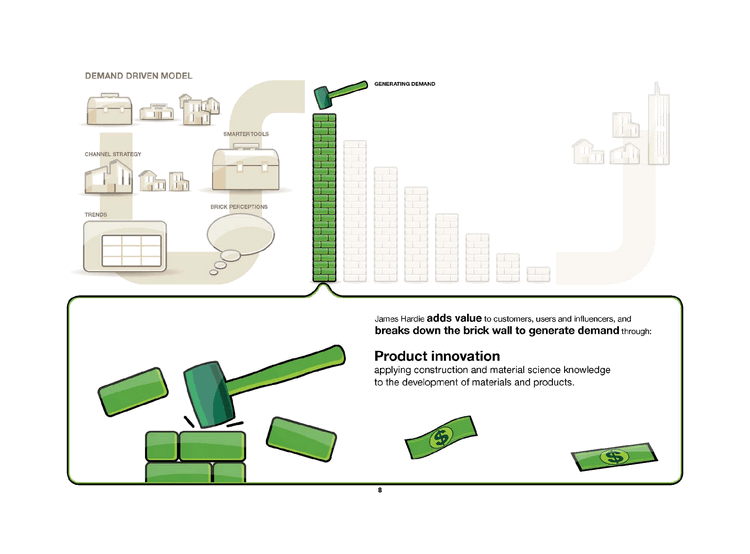
| DEMAND DRIVEN MODEL CHANNEL STRATEGY SMARTERTOOLS BRICK PERCEPTIONS GENERATING DEMAND TRENDS James Hardie adds value to customers, users and influencers, and breaks down the brick wall to generate demand-through: Product innovation applying construction and material science knowledge to the development of materials and products. |

| DEMAND DRIVEN MODEL CHANNEL STRATEGY TRENDS SMARTERTOOLS BRICK PERCEPTIONS GENERATING DEMAND James Hardie adds value to customers, users and influencers, and breaks down the brick wall to generate demand through: Accelerate a soon-to-be-launched suite of best-in-class specification and installation guidance tools. |
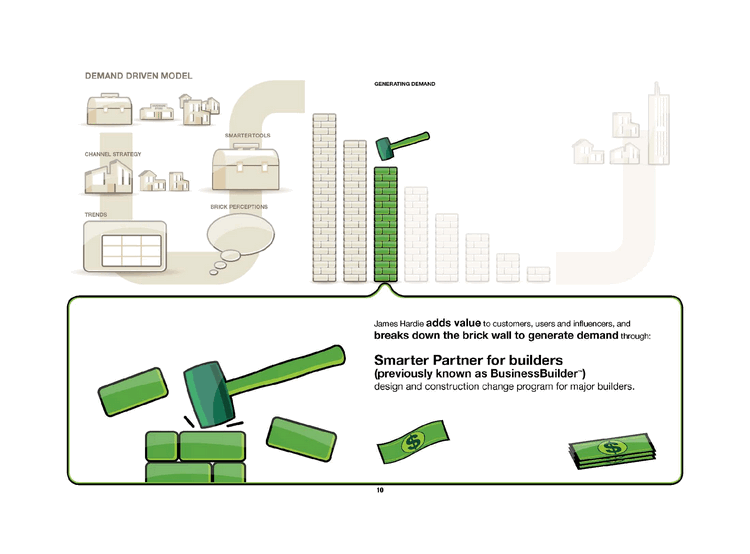
| DEMAND DRIVEN MODEL CHANNEL STRATEGY SMARTERTOOLS BRICK PERCEPTIONS GENERATING DEMAND TRENDS James Hardie adds value to customers, users and influencers, and breaks down the brick wall to generate demand through: Smarter Partner for builders (previously known as BusinessBuilder TM) design and construction change program for major builders. |

| DEMAND DRIVEN MODEL CHANNEL STRATEGY SMARTERTOOLS BRICK PERCEPTIONS TRENDS GENERATING DEMAND James Hardie adds value to customers, users and influencers, and breaks down the brick wall to generate demand through: Smarter Partner for developers built-form change program for selected developers. |
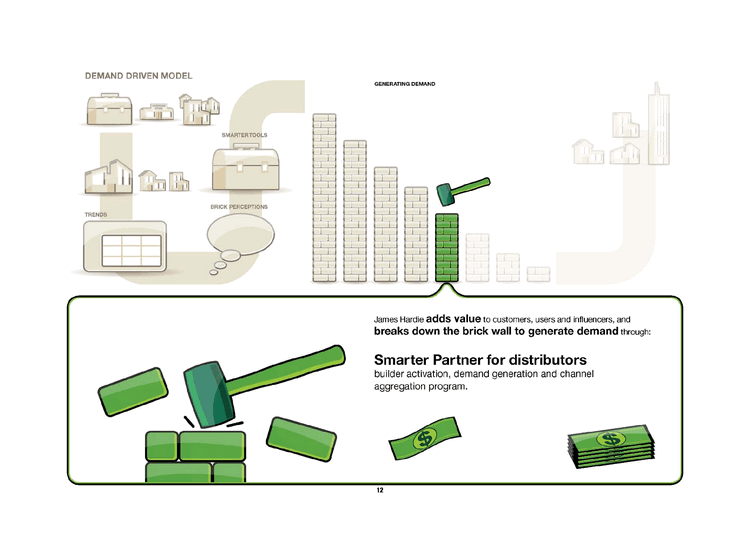
| DEMAND DRIVEN MODEL SMARTERTOOLS BRICK PERCEPTIONS TRENDS GENERATING DEMAND James Hardie adds value to customers, users and influencers, and breaks down the brick wall to generate demand through: Smarter Partner for distributors builder activation, demand generation and channel aggregation program. |
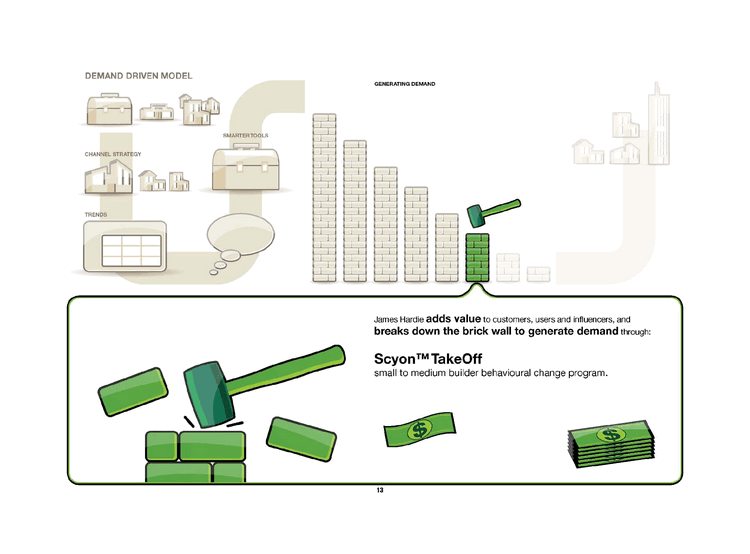
| DEMAND DRIVEN MODEL CHANNEL STRATEGY SMARTER TOOLS TRENDS GENERATING DEMAND James Hardie adds value to customers, users and influencers, and breaks down the brick wall to generate demand through: ScyoTM TakeOff small to medium builder behavioural change program. |

| DEMAND DRIVEN MODEL SMARTER TOOLS BRICK PERCEPTIONS TRENDS GENERATING DEMAND James Hardie adds value to customers, users and influencers, and breaks down the brick wall to generate demand through: LookHomTM trend accelerator and custom new home and renovation activation and proof vehicle. |
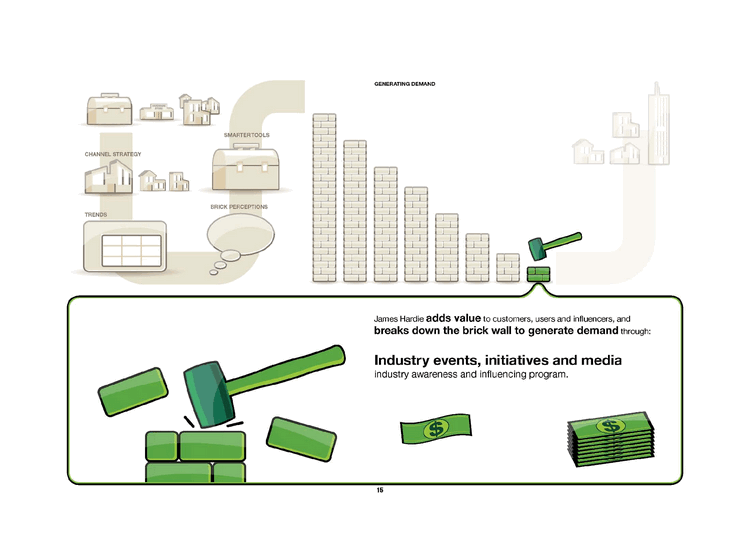
| CHANNEL STRATEGY SMARTER TOOLS BRICK PERCEPTIONS TRENDS GENERATING DEMAND James Hardie adds value to customers, users and influencers, and breaks down the brick wall to generate demand through: Industry events, initiatives and media industry awareness and influencing program. |
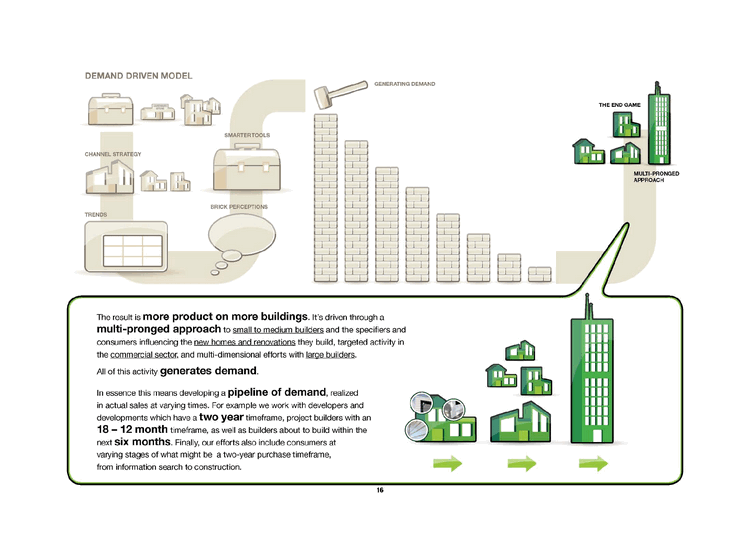
| DEMAND DRIVEN MODEL GENERATING DEMAND SMARTERTOOLS CHANNEL STRATEGY TRENDS BRICK PERCEPTIONS THE END GAME MULTI-PRONGED APPROACH The result is more product on more buildings. It's driven through a multi-pronged approach to small to medium builders and the specifiers and consumers influencing the new homes and renovations they build, targeted activity in the commercial sector, and multi-dimensional efforts with large builders. All of this activity generates demand. In essence this means developing a pipeline of demand, realized in actual sales at varying times. For example we work with developers and developments which have a two year timeframe, project builders with an 18 - 12 month timeframe, as well as builders about to build within the next six months. Finally, our efforts also include consumers at varying stages of what might be a two-year purchase timeframe, from information search to construction. MULTI PRONGED APPROACH THE END GAME |

| DEMAND DRIVEN MODEL GENERATING DEMAND CHANNEL STRATEGY TRENDS SMARTER TOOLS BRICK PERCEPTIONS PRODUCT ACCELERATE SMARTER SMARTER SMARTER SCYONTM LOOKHOMETM INDUSTRY INNOVATION PARTNER PARTNER PARTNER TAKEOFF EVENTS, FOR FOR FOR INITIATIVES BUILDERS DEVELOPERS DISTRIBUTORS AND MEDIA Go to Market Strategy James Hardie THE END GAME |